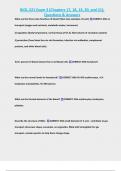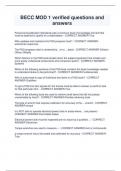BIOL-221 Exam 3 (Chapters 17, 18, 19, 20, and 21);
Questions & Answers
What are the three main functions of blood? (Give two examples of each) CORRECT ANS-1)
transport (oxygen and nutrients, metabolic wastes, hormones)
2) regulation (body temperature, normal tissue pH [7.4], fluid volume of circulatory system)
3) protection (from blood loss via clot formation, infection via antibodies, complement
proteins, and white blood cells)
Term: percent of blood volume that is red blood cells CORRECT ANS-hematocrit
What are the normal levels for hematocrit? CORRECT ANS-42-45% erythrocytes, <1%
leukocytes and platelets, 55-58% plasma
What are the formed elements of the blood? CORRECT ANS-erythrocytes, leukocytes,
platelets
Describe the structure of RBCs. CORRECT ANS-small diameter (7.5 um) - contribute to gas
transport, biconcave shape, anucleate, no organelles, filled with hemoglobin for gas
transport, contain spectrin to help them change shape
, BIOL-221 Exam 3 (Chapters 17, 18, 19, 20, and 21);
Questions & Answers
What is the most abundant protein in blood and what is its purpose? CORRECT ANS-
albumin (60%) - shuttles specific molecules through circulation, acts as a blood buffer,
maintains plasma colloid-osmotic pressure
How many molecules of oxygen can each hemoglobin molecule transport? What part of the
hemoglobin binds to the oxygen? CORRECT ANS-250 million molecules of hemoglobin;
heme (red pigment) binds to single oxygen molecule
Term: medical condition where blood has abnormally low oxygen carrying capacity that is too
low to support normal metabolism CORRECT ANS-anemia
Term: medical condition where there is an abnormal amount of RBCs, increases blood
viscosity, which causes a sluggish blood flow CORRECT ANS-polycythemia
Describe the life cycle of RBCs. CORRECT ANS-1) low oxygen levels stimulate the kidneys to
produce EPOs
2) EPO levels rise in bloodstream
3) EPO promotes erythropoiesis in red bone marrow
, BIOL-221 Exam 3 (Chapters 17, 18, 19, 20, and 21);
Questions & Answers
4) RBCs enter the bloodstream
5) old RBCs taken up via phagocytosis (lose flexibility -> hemoglobin degenerates -> spleen
traps fragmenting RBCs -> iron is salvaged from heme group -> remains of heme group
degraded to bilirubin -> globin proteins are metabolized or broken into amino acids)
6) raw materials uptake by blood for erythropoiesis
What are three characteristics that aid RBCs in transporting gasses? CORRECT ANS-1)
biconcave shape offers huge surface area relative to volume for gas exchange
2) hemoglobin makes up 97% of cell volume
3) RBCs have no mitochondria (ATP production in anaerobic)
What is carbon monoxide poisoning? CORRECT ANS-CO2 competes with O2 to attach to
hemoglobin molecules, prevents RBCs from transporting oxygen to tissues
What is erythropoiesis? CORRECT ANS-erythrocyte formation, produced at a rate of 2
million per second, regulated by hormones and diet (supplies of iron, amino acids, and certain
B vitamins)
, BIOL-221 Exam 3 (Chapters 17, 18, 19, 20, and 21);
Questions & Answers
What is the purpose of erythropoietin (EPO)? CORRECT ANS-glycoprotein hormone,
stimulates erythropoiesis, created in kidneys under hypoxic (low O2) conditions
What are three possible causes of anemia? CORRECT ANS-1) hemorrhagic anemia:
bleeding
2) low RBC production
3) high rates of RBC production
4) iron-deficiency anemia
Why is blood doping so dangerous? CORRECT ANS-EPO can increase hematocrit from 45%
to 65%, with dehydration concentrating blood even more; blood becomes like sludge and can
cause clotting, stroke, or heart failure
What is the function of thrombin? CORRECT ANS-enzyme that induces clotting by
converting fibrinogen and fibrin
Term: process in which plasmin becomes trapped in clot and later dissolves it, removes
unneeded clot when healing has occurred CORRECT ANS-fibrinolysis





